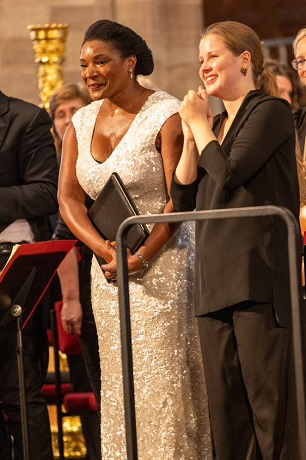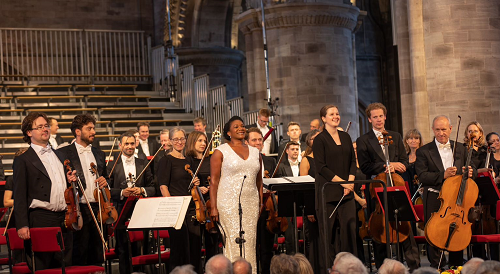For many, Richard Strauss’s Four Last Songs (1948) represent the last great flowering of German Romanticism. 84 years of age, worn down by the tribulations and devastation of the Second World War – most of Europe’s concert halls had been destroyed including the Munich National Theatre where his father had played first horn for 49 years – Strauss faced a world in ruins, and also a new musical ‘world order’, his luxuriant Romanticism seen as old-fashioned as favour fell on Schoenberg’s serialism and the spare neoclassical of Stravinsky and Hindemith. It’s tempting thus to see the Four Last Songs – radiant, opulent and wistful as they are – as a farewell to the musical past, to a lost world and to life itself. A last goodbye to nature, poetry and the soprano voice with which he had had a life-long musical love affair.
This Three Choirs Festival concert in Hereford Cathedral suggested, however, that Strauss’s transcendent epitaph was not in fact the last word in German Romantic musico-poetry. And, it seems serendipitous that it was a poem by the lyric poet Josef von Eichendorff, ‘Im Abendrot’ (In the evening glow), that in 1948 had caught Strauss’s imagination and encouraged him to pick up his pen once more, for Ich denke Dein… (I think of you, 2015) by the Swedish composer Rolf Martinsson concludes with another Eichendorff poem, ‘Mondnacht’, which similarly takes the listener into the sublime natural world and the stillness of the night. In setting five poems that speak with sensory and sensual excess of love and nature, Martinsson employs a sultry chromatic palette, a rainbow of orchestral hues and soaring melodic lyricism to create an erotically charged, unashamedly voluptuous post-Romantic idiom – a Straussian perfume infused with notes of Alban Berg and Broadway.
Moreover, if the presence of Strauss’s wife, the operatic soprano Pauline Maria de Ahna, seems to live through his music, then Ich denke Dein… was similarly inspired by the Swedish soprano Lisa Larsson, for whom Martinsson revised his song cycle for mezzo-soprano, Orchestral Songs on Poems by Emily Dickinson and composed Garden of Devotion, a cycle setting texts by the Indian poet Rabindranath Tagore, and who might be described as his muse. Composer and singer worked closely together on Ich denke Dein…, discussing details of the musical representation of the text, and the cycle is dedicated to Larsson who premiered the work in Zurich in January 2015.
On this occasion, the soloist was Elizabeth Llewellyn whose radiant soprano both soared effortlessly and floated with sublime gentleness, luxuriantly bathed in a kaleidoscope of instrumental textures and colours. Martinsson uses a large orchestra, including piano, harp and celeste which add a magical and ethereal dimension at times. He’s a skilful orchestrator, though, and just as the voice is never overwhelmed, so the instrumental fabric always works with rather than against the voice, as Martinsson crafts onomatopoeic images and fervent emotional landscapes. The Finnish conductor Emilia Hoving, making her UK debut, guided the Philharmonia Orchestra through the score’s riches with calm assurance, the gentle gracefulness of her gestures sometimes seeming to quell the more grandoliquent utterances.

The first song sets Goethe’s anaphoric ‘Nähe des Geliebten’ (The nearness of the beloved) – the four stanzas begin ‘Ich denke dein’, ‘Ich sehe dich’, ‘Ich höre dich’ and ‘Ich bin bei dir’ – which explores modes of imaginative perception that might bring the absent beloved close to the poet-speaker. That ‘nearness’ seemed embodied by the intensity of the lustrous orchestral introduction, the yearning melody of which returns later in the cycle. Martinsson makes concrete the visual impressions of the poem – the glint of the sun setting on the sea, the glimmer of the reflected moon in a stream, the dust rising on a distant road – and Hoving coaxed lovely aural images from the Philharmonia, a tactile canvas above which Llewellyn’s sensuous phrases glided. There was a retreat from opulence when the poet-speaker enters the silence of the tranquil grove, ‘to listen’ – a lovely, ambiguity and paradox. And though the orchestral postlude was rapturous the final cadence did not linger, as if the imagined perceptions were unsatisfactory when compared with the reality of the lover’s physical presence.
‘Liebeslied’ (Love song) and ‘Blaue Hortensie’ (Blue hydrangeas) set poems by Rilke. The finely spun, high vocal lines with which the former begins perfectly captured the tender vulnerability – the fear of falling in love – of the speaker’s question, “Wie soll ich meine Seele halten, daß/ sie nicht an deine rührt?” (How shall I hold my soul, that it does not touch on yours?). But, a brief relaxation was simply a prelude to an expansive outpouring of a passion which cannot be resisted, as the speaker’s realisations triggered a surge of vocal and instrumental heat:
‘Doch alles, was uns anrührt, dich und mich,
nimmt uns zusammen wie ein Bogenstrich,
der aus zwei Saiten eine Stimme zieht.
(But everything that touches us, you and me, takes us together like one bow-stroke which pulls one voice from two strings.)
‘Blaue Hortensie’ was more restrained, beginning and closing with declaimed text, and this seemed to deepen the psychological sophistication of the expression. The orchestral colours were darker, the shadows tinted with melancholy: the blue petals have faded to yellow, violet and grey; the leaves are dry, dull and rough. But, suddenly the blue lights up, and Martinsson’s harmony effected a propulsive rush, renewing nature’s energy, lifting Llewellyn’s glossy soprano aloft, and the song closed with a blazing harmonic image of “ein rührend Blauess ich vor Grünem freuen” (a touching blue rejoicing with the green).
Goethe’s ‘Die Liebende schreibt’ (The lover writes) relates to the moment in 1807 when the 58-year-old poet saw and fell in love with the 18-year-old Minna Herzlieb. There was more light and shade in this song, Llewellyn’s soprano softly unfolding over a relaxed pulse and easy harmonies. And while the final song, ‘Mondnacht’, began simply with Llewellyn’s purely spun phrase, “Es war, als hätt’ der Himmel/ Die Erde still geküsst” (It was as if heaven had silently kissed the earth), it quickly shifted into a different Romantic gear, welling up with a dark sensuousness that spilled from the voice into the instrumental interludes. Llewellyn wove her soprano delicately around the solo cello – which recalls the first theme of the first song – both lines soaring higher, expressing the stillness of nature at night, as the breeze gently swayed the ears of wheat and the woods rustled soft, the night sky clear with stars.

The entwining of the natural and the personal was conveyed by the thrusting give and take of the closing episode, brass and low strings prominent and driving, but in the final stanza Llewellyn’s pianissimo phrases glistened softly as the poet-speaker’s soul was released from earthly weight: “Flog durch die stillen Lande,/ Als flöge sie nach Hauss” (flew through the still lands as if flying home). The rich harmonic spectrum of the final cadence and the delicacy of Llewellyn’s closing utterances evoked a transcendent union of man and the eternal.
One complaint about Martinsson’s lush score might be that there is little rest from its sumptuous riches, nor noticeable variety of pace and pulse across the five songs. But, the orchestration is meticulous and at times masterly, the lyricism beguiling. If no-holds-barred, post-Romantic opulence is your thing, then this is a cycle to cherish.
In the second half of the programme Hoving and the Philharmonia presented Mahler’s Fourth Symphony. After the prevailing luxuriousness, the freshness that Hoving conjured was welcome. The first movement, ‘Bedächtig. Nicht eilen’, was fluid and serene but never flagging of energy. The Philharmonia string section was fairly moderate in size but not lacking in warmth, and the forces allowed woodwind solos to make their mark, made the horn tone pleasingly bright, and also enabled Hoving to expose the sensitive voice-leading and counterpoint. The strings’ phrases bore an appropriate Mahlerian wistfulness, but Hoving maintained momentum and good rhythmic definition.
The second movement, ‘In gemächicher Bewegung’, was fairly swift but with plenty of air to let the colours speak. Hoving might have dug deeper into the satire, but the music danced, if not quite with a heavy peasant’s stamp. The Adagio was quite special, though, the pizzicato double basses a quiet but sure presence, the cellos’ theme easeful in its simplicity, its repetitions through the movement acquiring an ever more sublime resonance. Hoving built strong momentum through the lively second theme and unleashed the power and passion of the brass as Heaven’s Gate opened, conjuring an uplifting joy.
The soprano soloist’s depiction of a child’s vision of Heaven in the final movement, ‘Sehr behaglich’, is simple in principle, treacherous in practice. Mahler pushes the singer quite lower at times, but Llewellyn reached down to the lowest notes with focus and clarity, and, as always, shone at the top. Even in the most pressing passages she communicated directly with her audience, enunciating the German text carefully but naturally, and really attending to the meaning. Vibrato was moderated to suggest the purity of the child’s vision, but not eliminated, and the result was a vocal tone that was even, comforting and affecting.
This was not a Mahler 4 in which many risks were taken, but it was a performance of impressive sensitivity, insight and tenderness.
Claire Seymour
Rolf Martinsson – Ich denke dein… Op.100; Mahler – Symphony No.4 in G
Elizabeth Llewellyn (soprano), Emilia Hoving (conductor), Philharmonia Orchestra
Hereford Cathedral, Hereford; Sunday 24th July 2022.